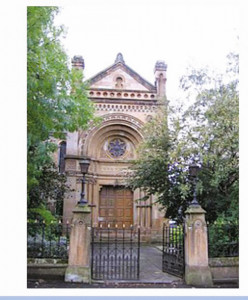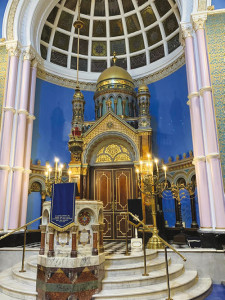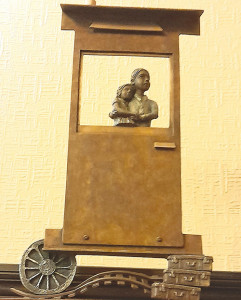
When you visit Glasgow, Scotland, you will find a very special treasure. Located in the heart of the city, Garnethill Synagogue is the first purpose-built synagogue in Scotland, the first synagogue to be built specifically for Jewish worship and not a converted church building. Garnethill shul remained the only purpose-built shul in Scotland in the 19th century. The building was designed by John McLeod of Dumbarton, in conjunction with London-based architect Nathan Solomon Joseph of the United Synagogue.
Opened in September 1879, Garnethill Synagogue is an Orthodox synagogue, still has an active congregation, is a beautiful example of High Victorian architecture and still retains its original stained glass windows, furniture and fittings. The synagogue is a Category A listed building, home of the Scottish Jewish Archives Centre and houses the Scottish Jewish Heritage Centre.
“The Scottish Jewish Heritage Centre (SJHC) was formed by a partnership of the Scottish Jewish Archives Centre (SJAC) who preserve and collect items relating to Scotland’s Jewish history and the Garnethill Synagogue Preservation Trust (GSPT) who maintain the historic building of Garnethill Synagogue,” said Kerry Patterson, manager, Scottish Jewish Heritage Centre. “So the building contains the Heritage Centre and Archives Centre as well as being home to the Garnethill Hebrew Congregation. The role of the SJHC is to enable and expand access to both the synagogue building and the collections contained within it. We have a team of volunteers who assist with school visits and public tours, and some of those guides are also congregation members, which is a very special connection for us and for visitors.”

Dr. Susan Siegel, the chairman of Garnethill Synagogue as well as Secretary and Trustee of SJHC, chairman of the West of Scotland Council of Christians and Jews, board member of Interfaith Scotland and originally from Buffalo, New York, commented: “We regularly welcome visitors from many places who are interested in learning about the history of Jewish people in Scotland or want to learn more about relatives who immigrated to Scotland. Our Grade A listed building is over 140 years old and houses a working Orthodox synagogue with services every Shabbat and all festivals. We are fortunate to have the support of government and private funders to maintain and enhance our beautiful building, including a Sukkah, function rooms, prayer hall and courtyard.”
The first Jew to settle in Glasgow was Israel Loeb Reiss, in 1803. Glasgow’s first Jewish community can be traced back to around 1821. Until that year, no sizable community or synagogue existed in the city. However, by 1831, 47 Jews lived there, most of whom came from Germany, Holland and Sheerness, England. The year 1850 saw 200 Jews living in Glasgow, and eight years later there was a new synagogue, the Glasgow Hebrew Congregation. By the 1870s, the community numbered around 1,000 and sought to build a permanent synagogue for the first time in Scotland because the converted synagogue on George Street, opened in 1858, was full.
Taking a guided tour of Garnethill Synagogue and the Scottish Jewish Heritage Centre affords the visitor the opportunity to learn about the roots of Scotland’s Jewish communities and how they have contributed to the country over the last 200 years. Visitors also learn about how the first Jewish congregation in Garnethill made an impact on the development of Victorian Glasgow and how the Scots helped Jews find safety from Nazi-occupied Europe in the 1930s and 1940s.
Dr. Elizabeth Cameron, vice chair of the board of the SJHC and former lord provost of Glasgow, in addition to being a volunteer guide, is the sole non-Jewish guide at Garnethill. “When my dad was a young boy, the family lived in the Gorbals area of Glasgow and were at one point the only non-Jewish people in their block of tenements. My dad used to help older Jewish residents around them on Sabbath and I didn’t even know there was a name for this, ‘Sabbath Gentile.’ He was so proud of that. Many of his friends were Jewish, and I was brought up to love and respect the Jewish community.

“I established a really good working relationship with the Jewish community, which has lasted many years,” Cameron continued, “and so when I heard they were looking to train guides for Garnethill, I was delighted to put my name forward. And that is why a Catholic with roots in both Ireland and Scotland is happy to find herself showing this beautiful building in Garnethill to the many visitors who make their way there.”
Cameron’s tours begin in the large community room downstairs, where she sets the scene and explains that Garnethill was the first purpose-built synagogue in Glasgow, opening in 1879, at the same time as the Municipal City Hall. “We … make mention of the various prominent Glaswegian Jewish people whose photographs are displayed,” she said. “The visitors are free to explore more of that room at the end of the tour. We then walk up to the prayer hall upstairs, taking in the display of a timeline chronicling the history of Jewish immigration to Scotland from 17th century when they came as traders or commercial venturers, through the huge outpouring from the Russian Empire when tens of thousands came to our country fleeing the Tsar’s pogroms, and then the third wave of refugees fleeing the Holocaust.”
“We then visit the prayer hall,” Cameron continued. “As a non-Jewish person, I am immensely interested in the liturgy and am learning more and more about it. We explain the differences between Orthodox and Reform Judaism, noting that Garnethill is Orthodox. The layout of the prayer hall is explained as are the ark, the bimah, the Hebrew inscriptions, the Prayer for Israel and the Prayer for the Royal Family. The scrolls of the Torah are viewed and the manner of worship in synagogues is also described. Prayer shawls and kippahs are laid out and their place in worship is also spoken of.
“Questions are invited and they are many and various!” Cameron emphasized. “From the prayer hall we go to look at the exhibits, many from family groups, that highlight ‘A New Life in Scotland.’ These tell the story of the communities in Glasgow, Edinburgh, Dundee and all over. Much is made of Jewish presence in the Gorbals on the south side of the city of Glasgow, a veritable melting pot where most immigrants resided at one time, apart from the Italians who were to be found all over the city. Prominent immigrants and refugees are highlighted including Cantor Ernest Levy, a survivor of the camps, and Marianne Grant, who survived because she was an artist whose work one Nazi commandant liked.

“Our last part of the tour is the Holocaust education permanent exhibition. A hugely important part of Garnethill in promoting Holocaust education. It concentrates on a well laid-out chronicle … of the awful progress of the Nazis and the consequent Shoah. It also highlights the refugees who came to Scotland, particularly the Kindertransport children, many of whom stayed here and flourished, and on those members of the community caught up in the war as combatants and as workers with refugees.”
Trevor Schuster-Davis, a retired lawyer, is another tour guide. “Garnethill Synagogue has been the only shul I have been committed to my whole life, and it is a pleasure for me to show visitors around,” he said. “I volunteered to be a guide when the Jewish Heritage Centre combined the shul with the Scottish Jewish Archives with support from the Scottish government and special donations from the German Institute in Glasgow towards the Holocaust element of our displays. My late brother Craig and I had our bar mitzvahs at Garnethill, and my sister Carole was married there. In the 1990s, I and the then-Chairman Gerald Levin and Treasurer Leslie Naftalin were instrumental in effecting a major refurbishment of the synagogue, raising money through Historic Scotland, some public and private trusts and private funds. The then-Chief Rabbi Lord Jonathan Sacks, zt”l rededicated the shul. So I am very proud of the shul and its history.
“Garnethill does have a regular Shabbat service and we have between 25 and 40 attending with a nice kiddush afterwards,” Schuster-Davis continued. “We also have services for all the main festivals, and Purim and Chanukah parties. Particularly in the summer we often have visitors from the U.S. and Israel, and indeed from all over.”
Schuster-Davis explained that there is always much to see, learn and focus upon when visiting Garnethill. “The synagogue is impressive, and the tour starts with the entrance vestibule and pointing out the marble plaques commemorating important ministers and others who have served the congregation and the Hebrew inscription reading, ‘Blessed be he who enters in the name of the Lord.’ The main vestibule has commemorative plaques for World War I and World War II with the names of the congregants who died and those who served and a yahrzeit board.

“Our most recent addition is an evocative sculpture by Glasgow Jewish artist Lyn Wolfson representing the Kindertransport. Two other main features are the Star of David Minton tiles from Stoke-on-Trent and the huge, fabulous stained glass window on the wall leading to the ladies’ gallery. A lovely backdrop for wedding photographs.
“We then enter the synagogue itself, lit during the day through lovely but paler stained glass windows of flowers and pomegranates, and as we pass the bimah, take in the Aron Kodesh, the marble pulpit with the Ner Tamid, the half cupula window with the first two letters of the Ten Commandments in one central pane. We open the doors to show the embroidered curtain and beyond the sefer Torahs with their embroidered covers and silver ornaments. We also have on show an open sefer Torah in perspex case with a yad and explain some details. We show a large Victorian chanukiah and other features including the now-unused choir stall.
“The only remnant from the 1858 building is the stained glass window with the Hebrew inscription ‘From the rising of the sun until its going down, the Lord will be praised.’ When mentioning the stained glass window I emphasize that there are no representations of people, no graven images. We also play a short cantorial piece of music, a recording of the late Cantor Ernest Levy.”
Tours of Garnethill Synagogue are also arranged for school groups. Younger age groups are engaged more in question and answers and are given pads to draw features they like, often a crown on top of a sefer Torah or a Magen David. Older groups are given more information, taken to a study room where they hear a talk about a Kindertransport child, given a “Learning Kit” containing special copies of foreign documents and photos of the Kindertransport child and listen to the story of their U.K./Scottish experience.
Tours also spend a short time in a newly refurbished kosher kitchen explaining why there are red cupboard door knobs for Fleishig and blue for Milchik and how significant food is to Jewish people, especially for festivals. Talks about Shabbat and festivals in the synagogue itself are given, depending on the group.
In the main Archives room, one wall is called the “Jewish Experience in Scotland” and contains about 20 photos and descriptions of various characters from Glasgow’s past and recent past. This room also houses some interesting artifacts and reference folders from provincial communities, now gone, charitable, sporting, arts/drama, youth groups, and Habonim Dror, “The Builders,” Socialist, Zionist, culturally Jewish youth movement founded in 1929 in the U.K. Arrangements can be made for further study if desired. A visit to the Holocaust-era information center, housed in the sukkah, contains fascinating information.
Both tour guides have favorite memories of time spent showing Garnethill Synagogue to visitors. “One of my favorite tours was escorting a party of 40 Jewish tourists from France,” said Cameron. “Many of them spoke English, but a large number did not, and I was so very grateful to be able to use my French to help them gain insight into the history of the Jewish communities of Scotland. It’s always great to welcome visitors to our city anyway and to put in context the historical importance of these communities in and of themselves but also in the community life of their adopted country which they served, and serve, so well.”
Schuster-Davis said: “On the World War II plaque, I point out the name Private Gerald Strump and say that he only died in 2020 at the age of 104, and that his father appears on the World War I plaque. In the Archives room I indicate the photograph of Marianne Grant, whom Josef Mengele used as an artist to draw for him in Auschwitz and who painted many watercolor pictures of what she had seen and were only revealed later in life. They are now in our major Kelvingrove Art Gallery in Glasgow, and we sell her book which has a lot of images, along with other books, cards and tartan kippot.
“I also like to show a newspaper article which was decrying the recent destruction of Mariupol in Ukraine and the treasures lost there, which include the photograph of a sefer Torah,” Schuster-Davis continued. “I explain how sacred the sefer Torah is as well as the significance of the calligraphy and the contents. And then there is the insight of a visitor on occasion, a question from an 8-year-old from a non Jewish school group: ‘Why are there no crosses in the synagogue?’ A guide is put on the spot, but I love it!”
When visiting Garnethill Synagogue, the main community today is in the south side of Glasgow, mainly the areas of Giffnock and Newton Mearns. In Giffnock, a few minutes walk from the train station, there is Giffnock Newton Mearns Shul, which has minyanim for all services and a men’s and ladies’ mikvah. The community is well catered for by two providers, L’Chaim’s Take-Away Restaurant and Catering and Mark’s Deli, also a few minutes walk from the station. These providers also deliver. Mark’s Deli is open six days a week and provides all kinds of kosher food, including ready-made meals for Shabbat. L’Chaim’s Take-Away Restaurant and Catering is under the auspices of Chabad in Glasgow, led by the Rabbi Chaim and Sora Jacobs, Lubavitch shlichim for more than 54 years. L’Chaim’s and Marks Deli are under the kashrut authority of Rabbi Moshe Rubin, head of the West of Scotland Kashrut Commission.
Rabbi Rubin, rabbi of Giffnock Newton Mearns Synagogue and senior rabbi of Scotland, told The Jewish Link: “Glasgow is a small community: 3,500 Jews. Despite this small size, we punch way above our weight. Other Anglo Jewry provincial communities of this size struggle to maintain a Jewish active presence. Our community is a very active community in all areas of Jewish life, religiously, culturally and socially.
“In the U.K. and Israel in all areas of communal leadership you find a strong Scottish influence. By visiting Garnethill Synagogue, the Jewish Archives Centre and the Scottish Jewish Heritage Centre, you get a flavor of the story of our community and you get an understanding of why this is the case.”
For more information: https://garnethill.org.uk, info@garnethill.org.uk,
L’Chaim’s: http://lubofscot.co.uk/lchaims/
Mark’s Deli: https://www.marksdeli.co.uk/
Susan R. Eisenstein is a longtime Jewish educator, passionate about creating special, innovative activities for her students. She is also passionate about writing about Jewish topics and about Israel. She has two master’s degrees and a doctorate in education from Columbia University.









